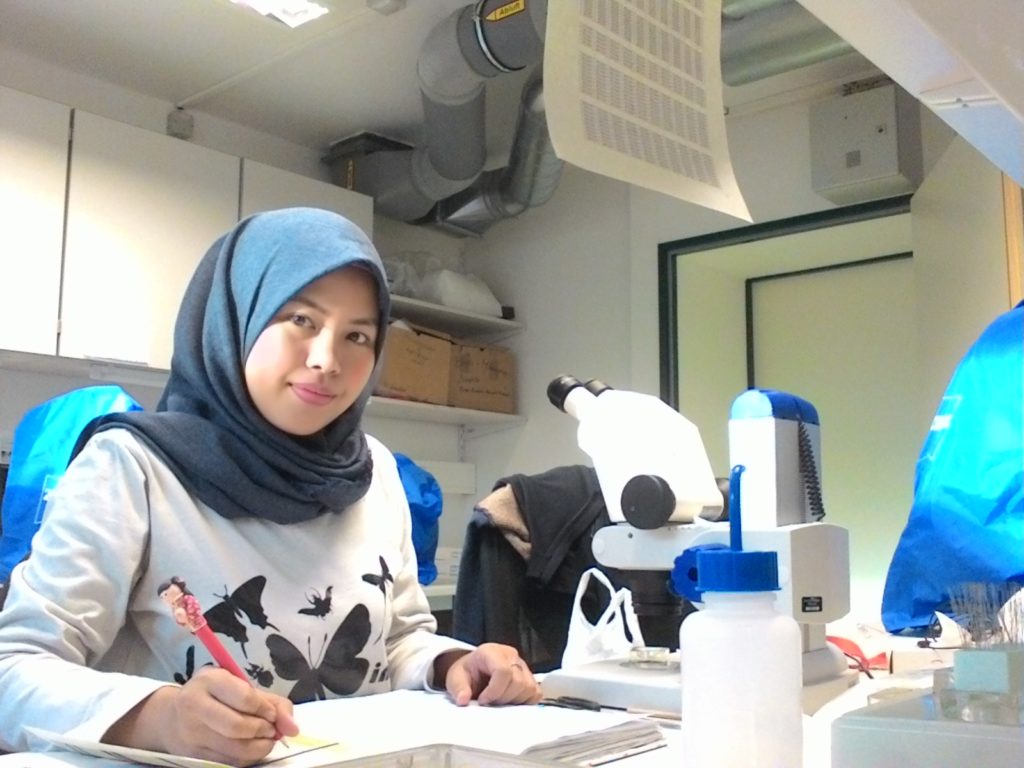Species loss and community shifts in canopy ants
Rizky Nazarreta is the first author of the recent article “Rainforest conversion to smallholder plantations of rubber or oil palm leads to species loss and community shifts in canopy ants (Hymenoptera: Formicidae)” published in Myrmecological News. Here, she briefly outlines the results of her and her colleagues’ research and highlights their main points.
An Interview compiled by Alice Laciny, Patrick Krapf, and Lina Padraza

MNB: Could you tell us a bit about yourself?
RN: It’s my pleasure to introduce myself to you. My name is Rizky Nazarreta, I’m 29 years old, and I’m from Indonesia. I have completed my bachelor’s and master’s degree from IPB University (Institut Pertanian Bogor). After finishing the bachelor in 2012, I felt I didn’t know what I wanted and should do, until one of my friends introduced me to Prof. Damayanti Buchori (biological control lab). In her lab, I started working part-time, identifying insects, especially ants that Jochen Drescher had collected in the EFForTS project (Ecological and Socioeconomic Functions of Tropical Lowland Rainforest Transformation Systems, Sumatra-Indonesia; http://www.uni-goettingen.de/crc990). Once I started looking at their morphology, I was completely fascinated. In 2014, I got an opportunity for an internship at the University of Göttingen, Germany, and joined Prof. Dr. Stefan Scheu (Animal Ecology). There, I learned a lot about the performance of molecular techniques and taking photographs of ants using super-sophisticated camera microscopes, which I didn’t find at my university. After returning from the internship, I finally became more convinced that I wanted to be a scientist and continued pursuing a master’s in entomology. The topic of my thesis was about diversity and identification keys of ants from Jambi (Sumatra, Indonesia). My main scientific interest is in morphology, taxonomy, and community ecology. Currently, I am still working as a research assistant in the EFForTS project. This project introduced me to the fascinating field of myrmecology. 🙂


MNB: Could you briefly outline your research on the topic you have published in Myrmecological News in layman’s terms?
RN: We have investigated the patterns of ant diversity in Jambi (Sumatra, Indonesia) in four different land-use types. The aim was to understand the ants’ community structure along a transformation gradient from secondary lowland rainforest, via jungle rubber to rubber and oil palm plantations.
MNB: What is the take-home message of your work?
RN: Humans are changing the Earth and doing damage, often in dangerous ways, which can have cascading effects on biodiversity and ecosystem function. Everyone has a responsibility to conserve insects for insects’ sake. If we fail, it will be even more difficult than today to get enough food, health, and freshwater for humans on this planet.
MNB: What was your motivation for this study?
RN: We don’t have a lot of people working on ants or studying ant ecology in Indonesia, especially referring to their morphology-based taxonomy and ecological distribution patterns.
MNB: What was the biggest obstacle you had to overcome in this project?
RN: I had to study the taxonomy of ants in close detail using the identification key to Bornean genera by Y. Hashimoto. We also have a lot of specimens in the Museum Zoologicum Bogoriense (LIPI Cibinong), but not many people who are working or specializing in taxonomy. So, I had to self-teach ant taxonomy like Yoshiaki Hashimoto. 😀
This was very challenging and I continued to develop my skills until (finally) we were able to finalize “A Guide to the Ants of Jambi (Sumatra, Indonesia)” (an update from the Y. Hashimoto identification book).

MNB: Do you have any tips for others who are interested in doing related research?
RN: Work with passion, fascination, and joy. These are the best things when you are excited by what you are studying.
MNB: Where do you see the future for this particular field of ant research?
RN: Hopefully to get people interested in ant taxonomy and ecology in Sumatra, and interest expert taxonomists to describe new ant species from my home country.
MNB: In a future interview, whom (researcher, PostDoc fellow, or PhD student) would you like to see featured?
RN: Alexander Wild and Yoshiaki Hashimoto.
MNB: Thank you for this interview!







Recent Comments